Philips PML 9009 is the manufacturer's top LCD television, using Mini LED backlighting. The device itself boasts excellent build quality, a stylish remote control, and the manufacturer's exclusive multicoloured Ambilight backlighting. In terms of picture quality, a slight drawback can be noted with the blacks and contrast, which, to be frank, are not among the best and will not deliver as deep and vibrant an image as is found in televisions in a similar price range. However, it is worth noting that due to good algorithms responsible for the picture, its tonal quality was very satisfying. Therefore, the relatively low brightness of the display is well masked here, and with the implementation of Dolby Vision technology, it allows for access to HDR materials. What definitely deserves attention is the fluidity of transitions, which were quite outstanding and better than in some significantly more expensive units. The greatest advantage of this television is its performance in gaming. No negative remarks can be made in this aspect, as the television truly shines and will certainly satisfy any user. The motion smoothing system is also one of the aspects worth praising the television for. With two sliders, whose effects are perceptible at every position, each user can find the best level of smoothing for themselves. Therefore, it can confidently be said that when choosing a television for sports, PML9009 Philips can be identified as an excellent candidate. Although the TitanOS operating system is currently in the development phase and lacks a considerable number of applications, we do not believe that the manufacturer will do nothing in this regard.
- Matching (Score)
- Our verdict
- TV appearance
- Where to buy
- Contrast and black detail
- HDR effect quality
- Factory color reproduction
- Color reproduction after calibration
- Smoothness of tonal transitions
- Image scaling and smoothness of tonal transitions
- Blur and motion smoothness
- Console compatibility and gaming features
- Input lag
- Compatibility with PC
- Viewing angles
- TV efficiency during daytime
- Details about the matrix
- TV features
- Apps
- Playing files from USB
- Sound
Philips PML9009 / 9019 / 9059 vs Hisense E8Q
Direct compare
The Xtra / PML9019 / PML9059 / PML9009 / PML9049 / AMBILIGHT TV
E8Q

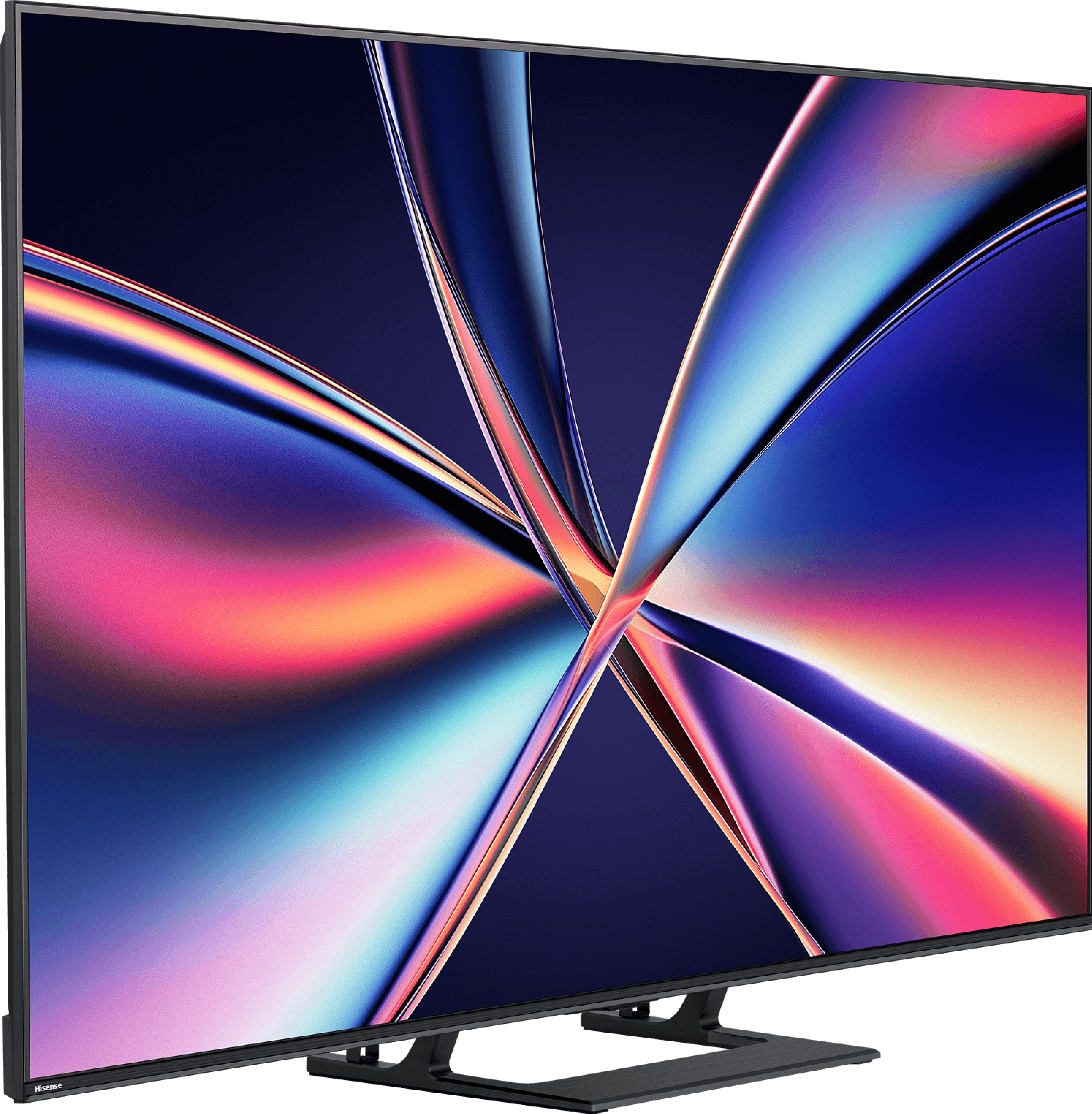
Panel type: LCD VA
Resolution: 3840x2160
System: Titan OS
Model year: 2024
Complete the survey to find out the result

Panel type: LCD VA
Resolution: 3840x2160
System: VIDAA
Model year: 2025
Complete the survey to find out the result

Overall rating
6.8
7.0
Movies and series in UHD quality
6.4
6.7
Classic TV, YouTube
6.3
6.8
Sports broadcasts (TV and apps)
6.6
6.5
Gaming on console
8.5
8.0
TV as a computer monitor
8.6
8.6
Watching in bright light
6.1
6.2
Utility functions
6.0
8.9
Apps
6.2
7.7
Sound quality
6.7
5.5
Complete the survey to find out what fits your preferences
Advantages
Very good tonal range of scenes exceeding the capabilities of the television
Well-functioning dynamic tone mapping feature
Colour reproduction after calibration
Performance after connecting to a console/PC
Great contrast and deep blacks
Very good fluidity of tonal transitions (close to reference level)
High brightness
Support for 4K 144 Hz and even 240 Hz in Full HD
VRR, ALLM, G-SYNC – a complete package for gamers
Low input lag
Many classic television features integrated into the VIDAA system
Disadvantages
Considerable halo/bloom effect
Poor viewing angles
The TitanOs system is not as advanced as the competition
Average contrast and black levels
No support for HGiG (makes setting up HDR on consoles difficult)
Poor viewing angles – typical for VA panels
Closed VIDAA system – lacks some applications
Inferior sound quality compared to the twin model U7Q
Our verdict
The Hisense E8Q is a television that clearly draws heavily from the U7Q model – and very well so. After all, it is his European version, not another "slimmed down" mutation. Just moments with this screen reveal that the E8Q is putting up a fight. And in many respects, it really succeeds. To start with – what impresses: the blacks are deep, the contrast is high, and the brightness exceeds a level we can simply call satisfactory. Add to this almost perfect fluidity of tonal transitions and we have an image that looks very mature, especially for this price segment. In gaming? Just as good. Support for VRR, ALLM, 144 Hz in 4K and even 240 Hz in Full HD – it's hard to nitpick here. Well… almost. Because the E8Q has one additional flaw compared to the U7Q – sound. In our unit, even at moderate volume levels, the back of the casing began to resonate, generating rather unpleasant crackles. This could be a fault of the test unit, but since the U7Q simply performed better – it’s worth noting. Especially if you find both models at a similar price. We can confidently say that the E8Q is a television that can boldly compete for the attention of those seeking a quality Mini-LED at reasonable prices. If a good price opportunity arises, it is simply worth it – because we get almost the same as in the U7Q. And that means a really solid picture, great gaming features, and overall a very good piece of equipment that one can stick with for a longer time.
TV appearance




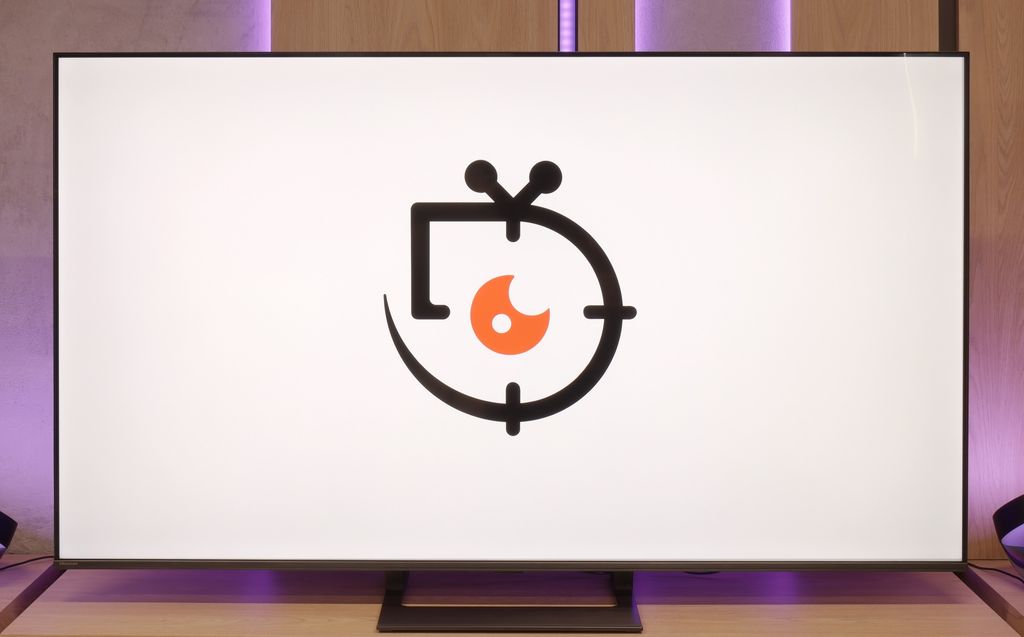
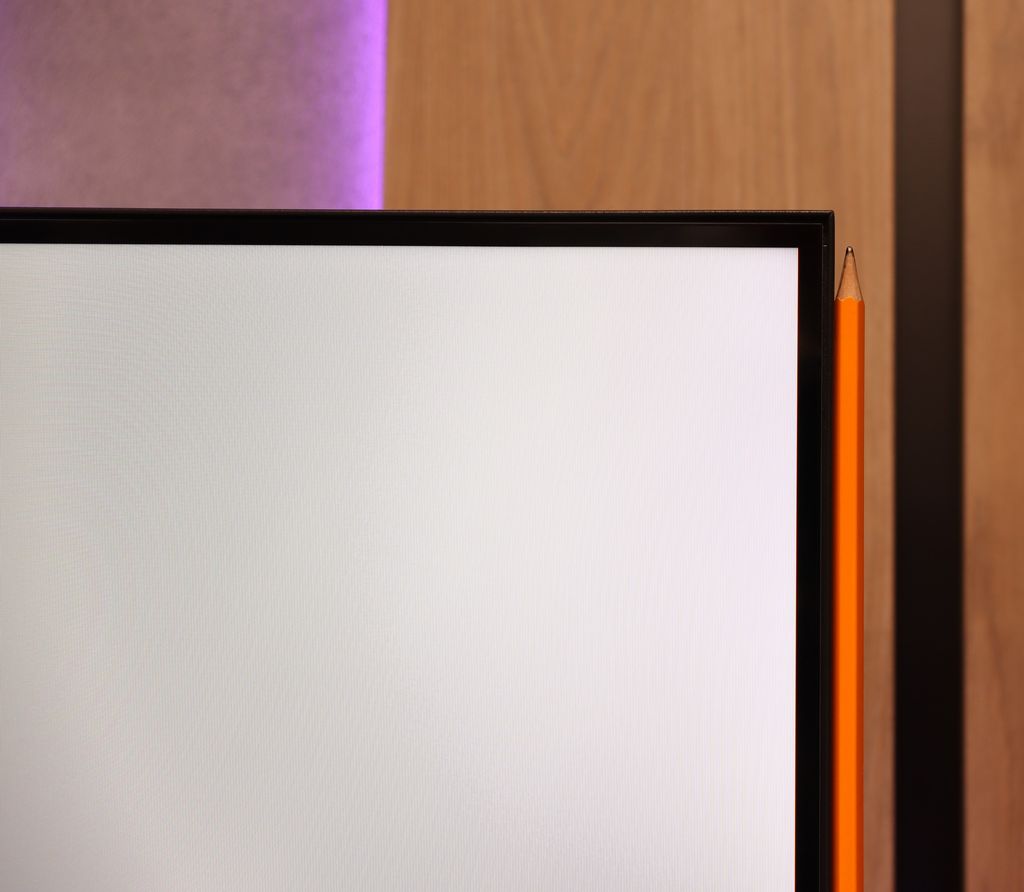
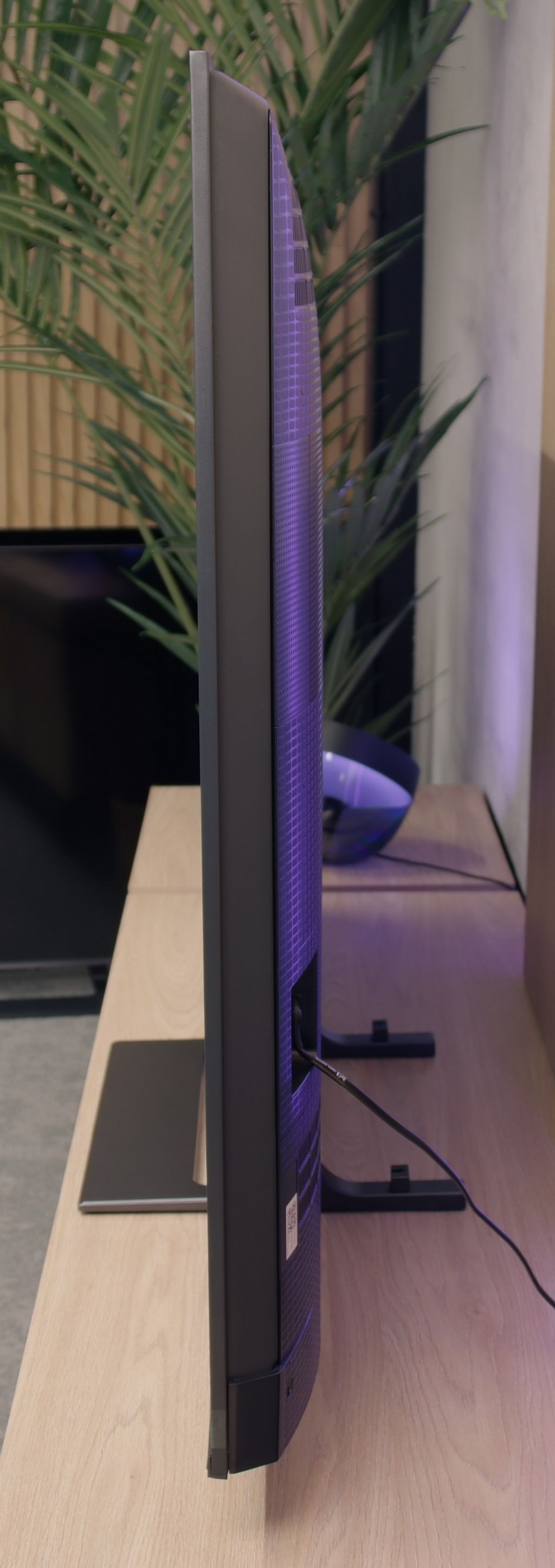
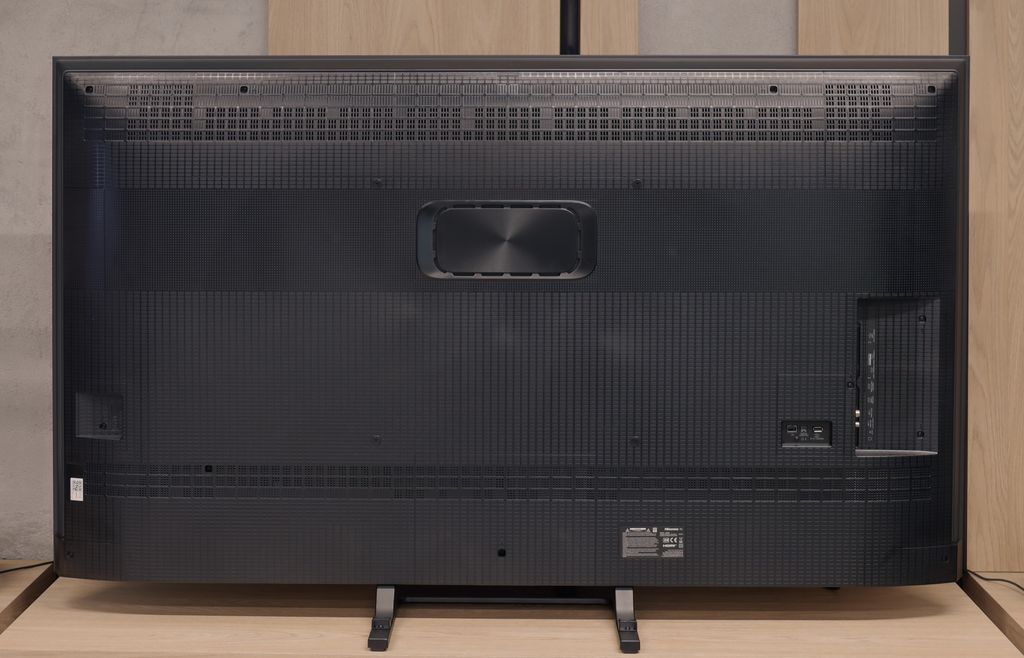
Contrast and black detail
6.6/10
7.6/10
Local dimming function: Yes, number of zones: 75 (15 x 5)
Local dimming function: Yes, number of zones: 220 (10 x 22)
Contrast:

Result
132,000:1

Result
16,550:1

Result
14,450:1

Result
7,850:1

Result
6,650:1

Result
277,000:1

Result
43,700:1

Result
15,750:1

Result
8,850:1

Result
6,350:1
Halo effect and black detail visibility:

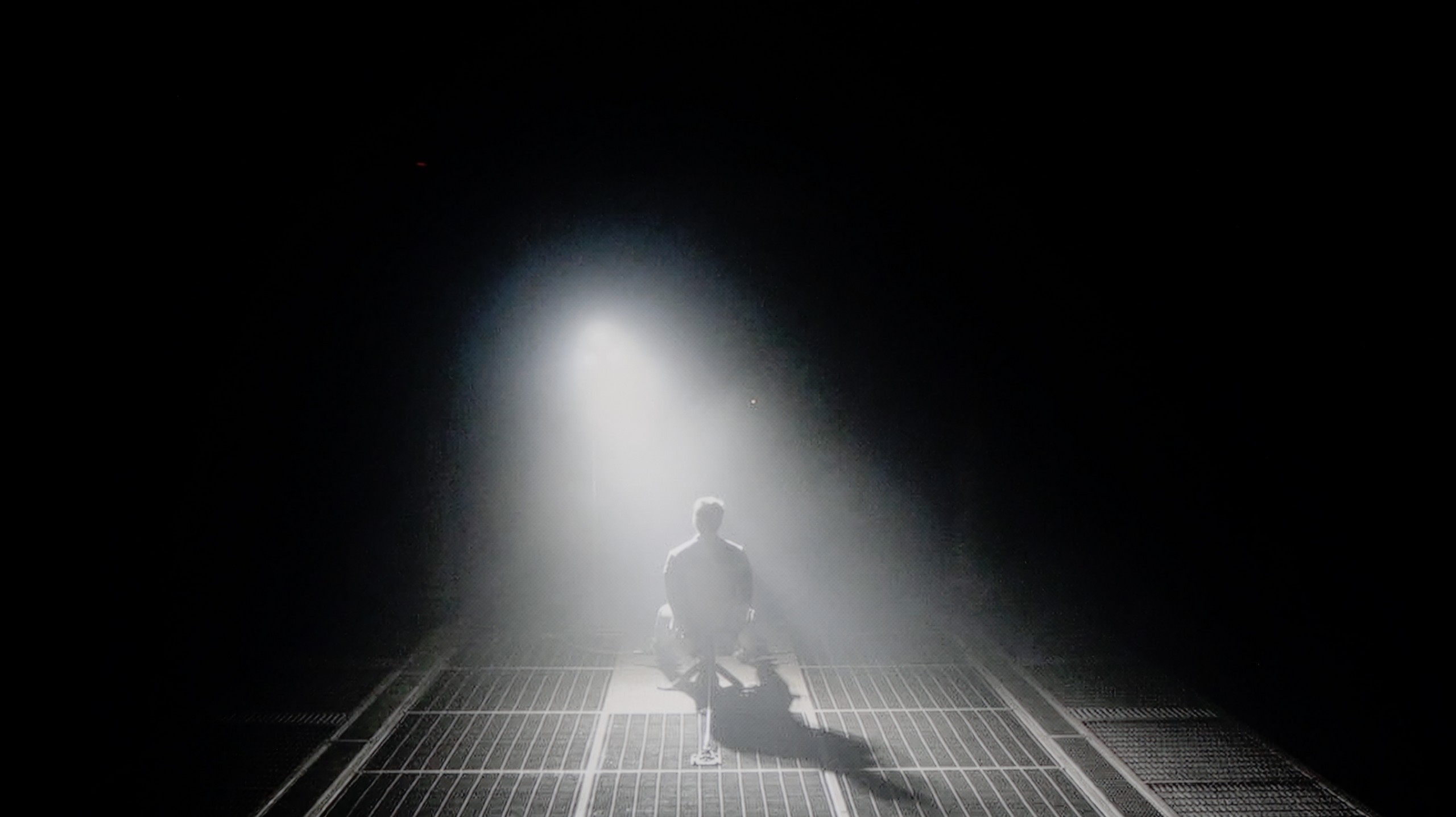
Philips PML9009 is equipped with a high-contrast VA panel. Although it does not deliver as deep and three-dimensional an image as OLED televisions, it is still a much better solution for home cinema compared to IPS/ADS panels. The measured static contrast (without local dimming activated), which stands at 6000:1, can be considered very good and allows for the full potential of the Mini LED backlighting that has been implemented in the tested television. The results of the contrast and black measurements, as you can see for yourselves, are not among the highest, and the only scene where the television demonstrated satisfactory results was that from the film "Oblivion," where the unit can be commended for its light separation, which is not so obvious even in much more expensive units. We should also mention that all tests were conducted at medium dimming power, as the lowest option produced unsatisfactory black levels, while the highest lost a significant amount of detail. Unfortunately, our standard testing procedure with the film "Sicario 2" did not go very well. Yes, all the details in the background are very well visible, but due to the operation of the dimming zones, the overall tone was significantly thrown off, not to mention the strong halo effect around the bright elements of the helicopter.
Similar to the U7Q, the E8Q model uses a VA panel and Mini-LED backlighting. The number of dimming zones also remains at a very similar level – in the 65-inch variant we tested, we counted 220 zones, which is exactly the same as in the U7Q. On paper, this looks really good for this price segment, but even better – in practice. The contrast is high, and the black can be really deep. In many scenes, the lights are clearly separated, and the image gains a sense of depth. This is one of those cases where Mini-LED shows that it can approach the quality of OLEDs – of course, assuming that we understand the limitations we have to contend with. In very challenging scenes, there may be slight brightenings or a small halo effect around bright objects, but these phenomena are typical of this technology and do not stand out strongly. Ultimately – the contrast and blacks in the E8Q are really solid, almost identical to those in the U7Q model. It’s hard to find anything to criticise here, especially when we consider the price of the television.
HDR effect quality
6/10
4.5/10
Luminance measurements in HDR:

Result
548 nit

Result
550 nit

Result
824 nit

Result
491 nit

Result
582 nit

Result
531 nit

Result
148 nit

Result
320 nit

Result
100 nit

Result
625 nit
Scene from the movie “Pan” (about 2800 nits)


Scene from the movie “Billy Lynn” (about 1100 nits)


Static HDR10


Dynamic: Dolby Vision
Dynamic: Dolby Vision


HDR luminance chart:
Hisense E8Q
Luminancja HDR
Luminance of RGB colors
Philips PML9009 / 9019 / 9059
Luminancja HDR
Luminance of RGB colors
Philips PML9009 does not really operate at the highest values in HDR content. Most effects with brightness at around 550 nits will not leave us thrilled with the lighting effects, although they are quite stable, which is a plus and will make a considerable difference compared to SDR content. It is worth noting that we can only achieve a good result in one scenario, namely in the film "Gemini", where the flashlight as the only light source can shine. Why in that scene specifically? The answer is quite simple. The scene itself does not contain a large amount of black, and the flashlight is not as large an object as the sun in the first and last scenes. Overall, the brightness measurement results in HDR content do not provide a basis for recommending this television for viewing productions that utilise a wide colour spectrum. Although it is worth noting that this model can cover it to a decent extent of 93% in the case of the DCI-P3 palette.
Since the E8Q is a twin of the U7Q, it’s no surprise that the quality of the HDR effect is nearly identical. On paper, it looks promising – a peak brightness of 800 nits can impress in many scenes. Moments such as flashes of light in “The Meg” or shots of the sun in “Life of Pi” can indeed evoke a 'wow' effect. But the longer we watch, the more we notice the limitations. The problem arises when small, bright details need to be shown against a dark background. In such situations, the dimming algorithms try to preserve contrast but end up dimming what should shine the most. Instead of dazzling details, we get almost invisible points of light. This is typical for Mini-LEDs in this price segment and is not surprising – but it’s worth knowing that the HDR effect will not always be fully preserved. Fortunately, the colour performance offers reasons to be pleased. Coverage of the DCI-P3 colour gamut at around 94% is a very good result, and the applied layer of quantum dots (more precisely, PFS) does its job – the colours are saturated and vibrant, especially with 4K content.
Factory color reproduction
5.3/10
6.5/10


Factory Mode
After calibration
The best factory mode used during our tests was "Filmmaker". Here, we will look at both SDR and HDR content. The element that distinguishes them is primarily the EOTF curve in materials with a wide colour gamut and the gamma in those recorded "the old way". Starting with SDR films and series and the most basic thing we can observe, which is white balance, we see a significant dominance of red colour. This led to a yellow tint across the entire image, causing unnaturally looking faces and yellowed whites. This flaw is also evident on the "ColourChecker" palette, where all colours have shifted towards their warmer counterparts. Looking at a more significant graph, that of the gamma responsible for image contrast, we see considerable errors starting from the very beginning. From the left, the value we measured, marked by a connected ellipsis, clearly spiked upwards, causing complete merging of details in the darkest scenes. This state of affairs remained until 10% screen brightness, after which it dipped below the reference orange line, leading to a deterioration in contrast, which, as we know, the Philips PML9009 already lacks. In HDR materials, the white balance issues were very similar to those in SDR content. The discrepancy arises when checking the EOTF curve, which controls the rate of brightness increase and severely limited it, causing the image to appear unnaturally dark. As for the colours themselves, there were more reasons for concern here, as the television's too low luminance caused a huge discrepancy between the actual state and the correct one, which is perfectly visible on the error graph, often exceeding the scale.
Testing the Hisense E8Q in Filmmaker mode, we were hoping for a possibly neutral image close to the director's vision. Unfortunately – although it doesn't look bad on paper (the colour reproduction errors are not significant), in practice the image appears not entirely natural. The reason? An overly strong boost in blue colour and a lack of red in the white balance. The effect? Scenes look cool, and the white seems slightly bluish. Alongside the U7Q model, we also noticed a specific approach to brightness management here. The brightness mapping curve for HDR content (EOTF) shows that the television can significantly dim small, bright elements on the screen to maintain contrast – but sometimes it goes too far in this. On the other hand, larger, very bright areas can be excessively brightened, which disrupts tonal balance. This is a compromise that may not suit everyone – especially if you want an as faithful image as possible right out of the box.
Color reproduction after calibration
7.5/10
7.4/10




Philips PML9009, like most leading manufacturers, has been offering advanced tools for the calibration process for years. Thus, we find 2- and 20-point greyscale adjustment as well as an advanced CMS (Colour Management System). The differences resulting from calibration are evident, and even someone not paying attention to picture quality (although there probably aren't many such here) will notice a positive difference. Both SDR and HDR materials have undergone a significant transformation. The former, as well as the latter, have primarily rid themselves of the unpleasant yellow tint resulting from a red colour dominance in white balance. As for the SDR materials and gamma, although it is not 'lined up' perfectly and still loses dark details, the rest of it is on a more than decent level, and minor errors will not be noticeable. The colours themselves look infinitely better, and thanks to low deltaE errors, they are nearly reference-quality. On the other hand, the HDR materials, due to the low luminance of the unit, were not blended as we would have liked. Although the white balance has been largely normalised, here and there one can notice a slight blue tint. Fortunately, the EOTF curve turned out to be much more accessible and allowed for practically ideal geometry. Unfortunately, due to the screen's insufficient brightness, colour errors are still quite high.
The calibration of the Movie mode yielded really good results, especially when it comes to SDR content. We managed to balance the white levels, which made the image look more natural – it appeared almost reference-quality. The colours were well-saturated, and the overall perception of the content improved significantly. Unfortunately, when we switched to HDR materials, familiar issues from the U7Q model returned. The television still likes to "do its own thing," as evident from the analysis of the brightness characteristic EOTF – despite calibration, the E8Q still dimmed fine details in the shadows, while the bright areas of the screen could be excessively boosted. In practice, this means that in darker scenes, some of the smallest details could simply disappear. Although it must be acknowledged that the entire calibration process brought a lot of good, not everything can be circumvented – even with the use of professional tools. The E8Q can impress with its picture, but in HDR content, its design limitations become apparent, and it is worth keeping this in mind.
Smoothness of tonal transitions
7/10
9.9/10







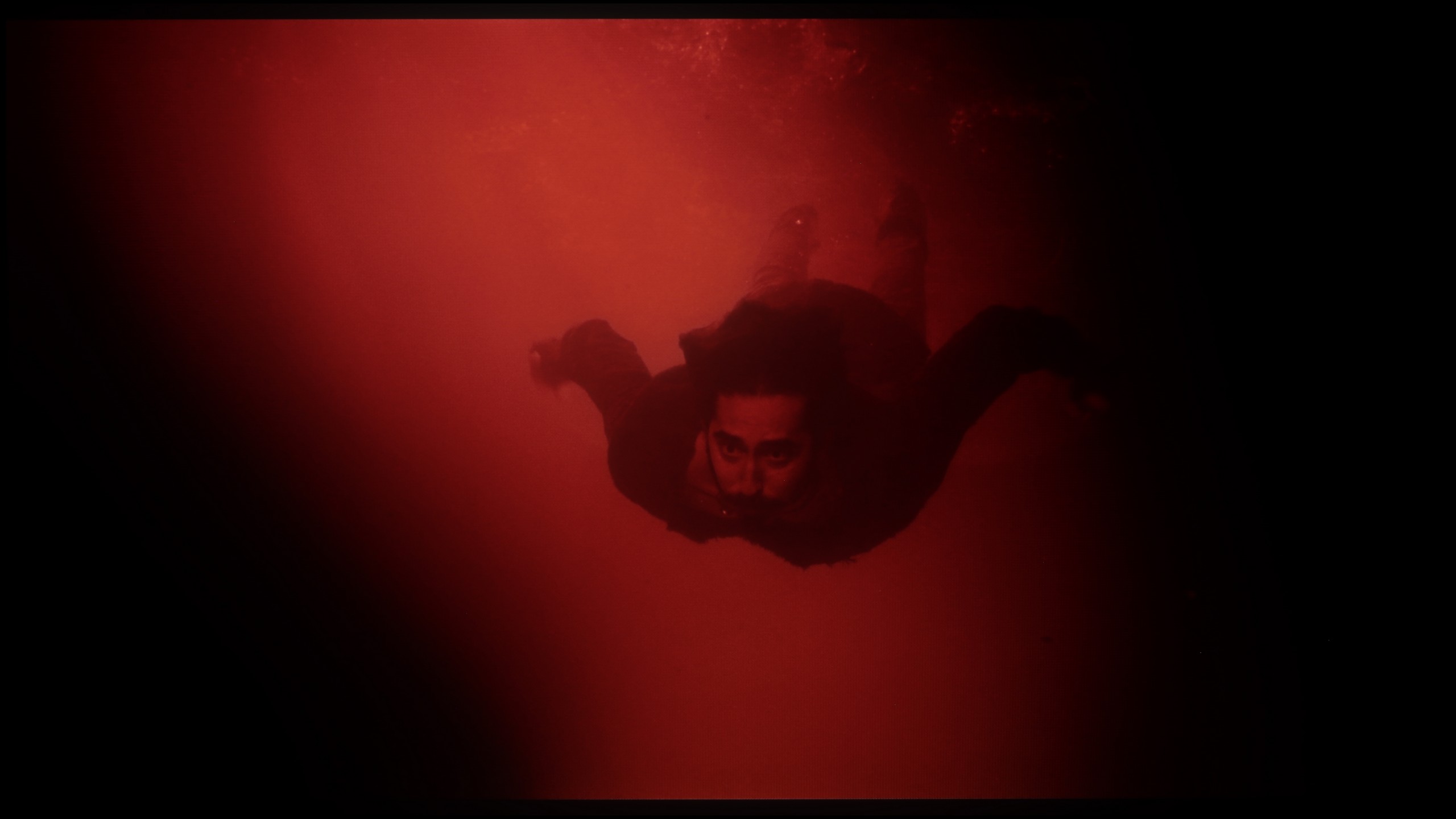




Undoubtedly, many of you have watched a film or series in which there were bands that should have been a smooth transition between colours. Therefore, during our tests, we also pay attention to tonal transitions. Philips PML9009 handled this matter quite correctly with each of the scenes we prepared, and although there are signs here and there of elements that could have been processed better, it is still good. It is particularly worth noting the one from "The Green Knight", which is definitely the most challenging. For the tested television, it did not prove to be a "killer" and there are no significant undesirable stutters visible in it.
In this category, the Hisense E8Q really demonstrates class. The transitions between colours are very smooth, with no 'banding' or clear boundaries between tones. The image looks natural, and the colour gradation is exceptionally good – even in more difficult scenes. If there are any minor imperfections, they are subtle enough not to be noticeable. It's hard to nitpick here – it looks almost flawless.
Image scaling and smoothness of tonal transitions
7.2/10
6/10
Smooth transition function


Image without overscan on the SD signal


Judging by how PML9009 Philips handled tonal transitions, the image scaling test should perform equally well. This time we are examining the television's algorithms responsible for enhancing the quality of images that have been recorded in lower quality. Such images can be found in various television programmes or older films. In this regard, Philips PML9009 performs quite mediocrely and significantly blurs the image. This is particularly evident in fine branches or the model's hair.
We will take another look at the tonal transitions, which performed remarkably. Within the unit, we find several levels of smoothing. Even the lowest setting can effectively eliminate any non-fluid tonal transition and will work well with the vast majority of content. More importantly, none of the settings for this function softens the effect of film grain, which is extremely important in terms of alignment with the director's vision. However, we note that sometimes it may turn out that fine details will be blurred.
In the case of older materials with lower quality, a gentle smoothing of tonal transitions often comes in handy. The Hisense E8Q, like the U7Q, features an "Smoothing and Gradient Image" function, but unfortunately – its effectiveness leaves much to be desired. The "Low" mode is almost imperceptible in operation, and the higher settings do not improve transitions but simply blur the details. The good news is that the function does not compromise film grain, meaning it does not worsen the structure of the image. On the plus side, scaling is commendable. The television is able to sensibly upscale older content to a higher resolution – without artificially accentuating contours or excessive sharpening. Although it does not match the best models in this category, it performs quite well for its class.
Blur and motion smoothness
7.7/10
7.5/10


Blur (native resolution, maximum refresh rate):



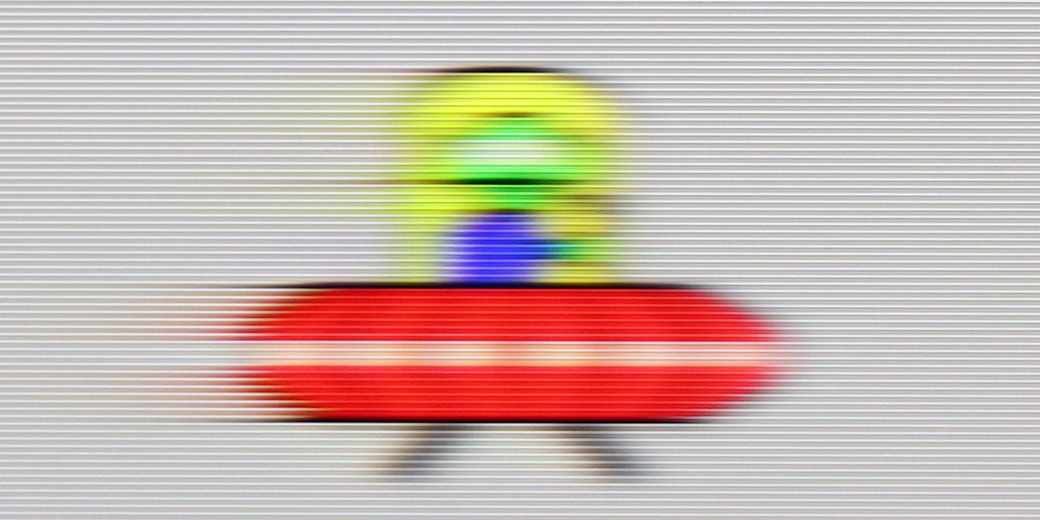


Blur (BFI function enabled):



Smużenie ():
Smużenie (4K 120Hz):
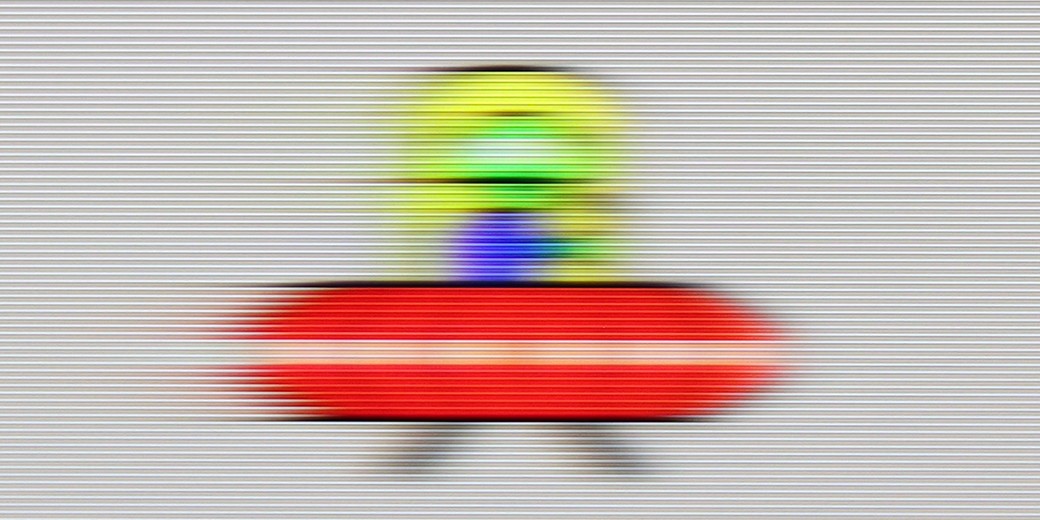

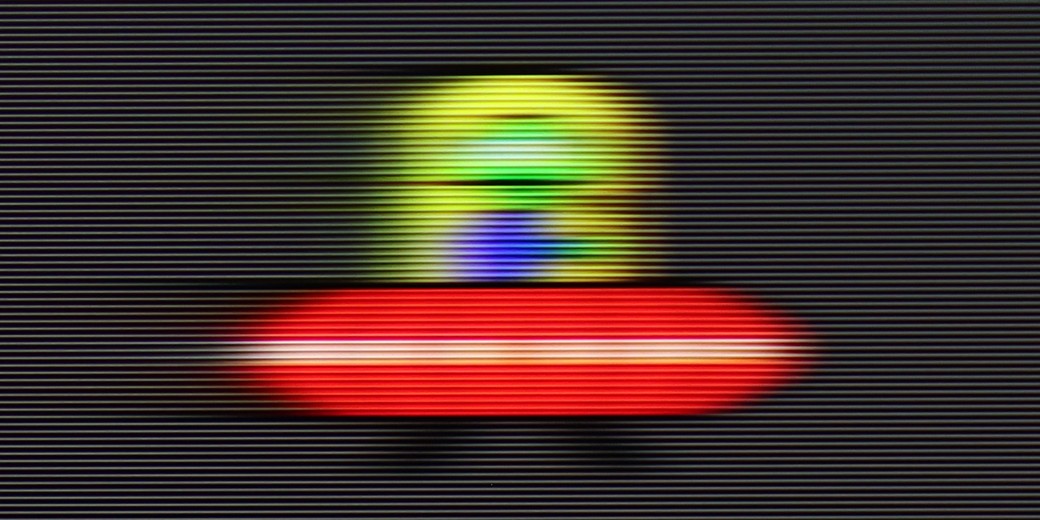
Philips PML9009 is equipped with a panel that has a native refresh rate of 120 Hz. This is the essential minimum for watching all kinds of sports and is recommended for comfortable gaming in favourite titles on consoles or PCs. The manufacturer has prepared an effective system for improving the sharpness of moving images for those who do not like the characteristic stuttering of footage recorded at 24 fps or require a high level of motion fluidity, for example, when watching football matches. In the dedicated tab, we find the "Fluidity" slider, which helps eliminate stuttering, and "Motion Blur Reduction," which aids in increasing the sharpness of dynamic elements. This function works very well and granularly, meaning each setting has a real impact on the perception of motion. With such a set, every user will find their sweet spot. In the picture, we present our choice, which is a slight fluidity enhancement without the soap opera effect.
A matter directly related to motion is the pixel response time of the panel itself. The best in this regard are, of course, OLED panels, followed by IPS and ADS-based units, and finally, VA. Despite the overall good quality of the systems responsible for smoothing the image, the use of a VA panel carries consequences in the form of a black halo behind fast-moving objects. While this will not occur frequently in the tested television, it will be visible here and there.
Similar to the U7Q, the E8Q model is a fast television designed for dynamic content. It supports a refresh rate of 144 Hz at 4K resolution, and if, for some reason, someone is still gaming in Full HD – it can even reach 240 Hz. This is a significant advantage, especially for PC users looking for maximum smoothness. In everyday use, the television performs very well. The "Ultra Motion Smoothness" mode offers two sliders that allow you to customise the picture to your preference – whether more cinematic with the film frame preserved or highly smoothed, almost "series-like". It's good that the manufacturer provides a choice here instead of imposing one style. On sports material, live broadcasts, or in games – movement looks clean and stable. Of course, it is not at the OLED level, but for this price range, the E8Q performs really well.
Console compatibility and gaming features
9.8/10
8.5/10
- ALLM
- VRR
- VRR range48 - 144Hz48 - 240Hz
- Dolby Vision Game Mode
- Correct implementation of HGIG
- 1080p@120Hz
- 1440p@120Hz
- 4K@120Hz
- Game bar



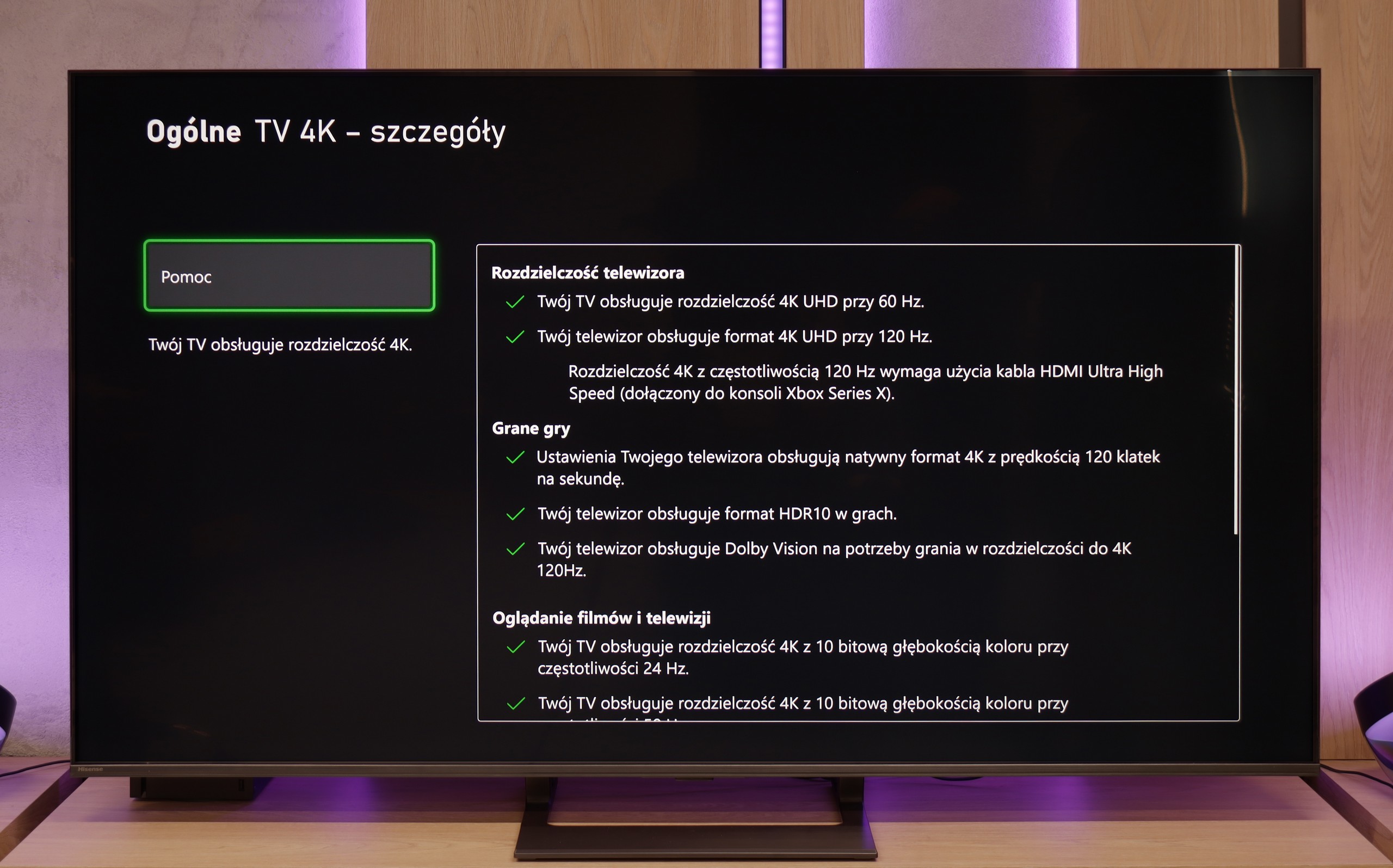

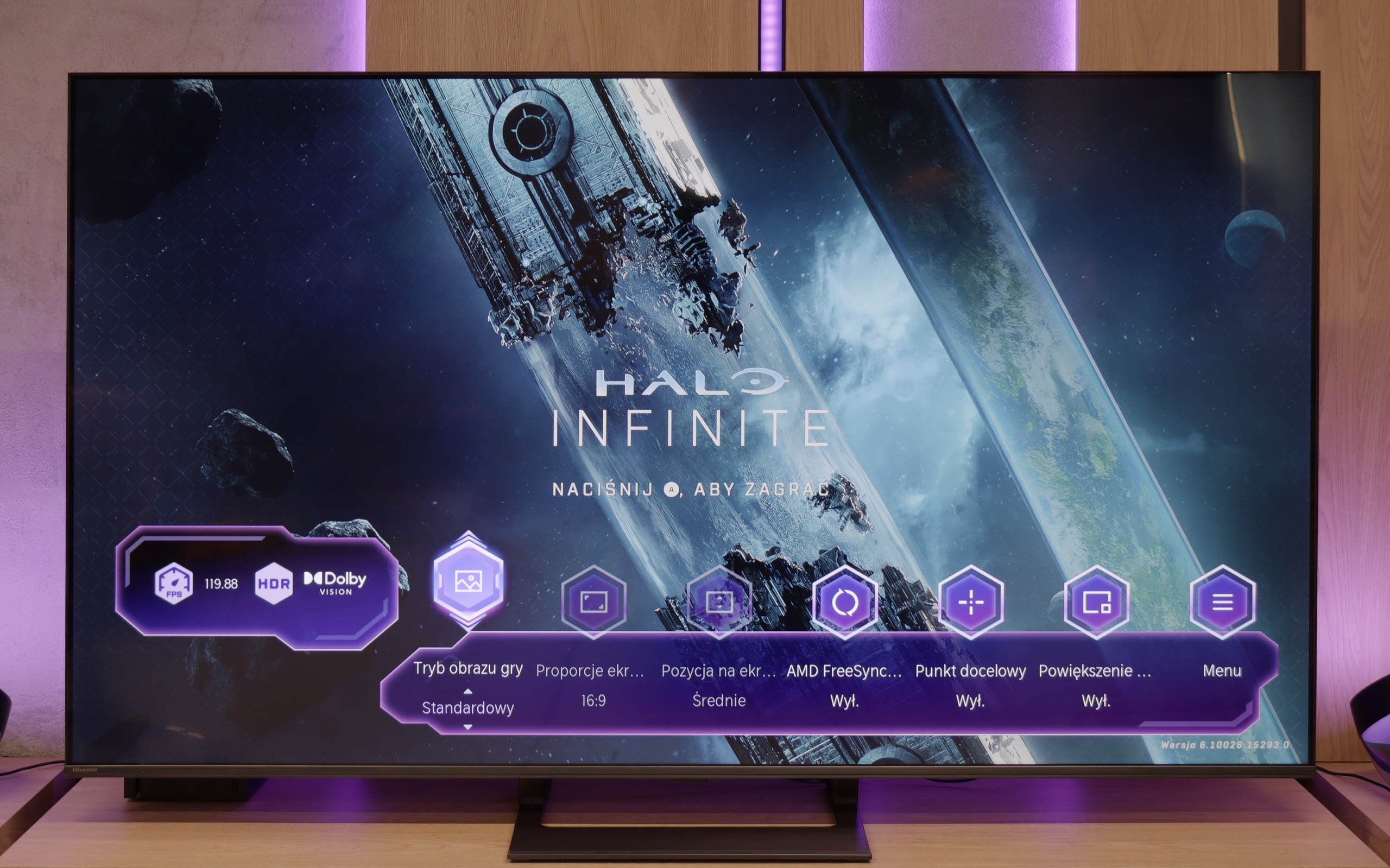


Philips PML9009, equipped with HDMI 2.1 ports at full bandwidth, supports all features dedicated to gamers. The most basic ones, such as VRR and ALLM, are a given, but G-Sync, FreeSync, and gaming in HDR Dolby Vision with low input lag are not. These features activate without any issues and during the tests conducted, they did not present any problems. Such preparation of the television is certainly a strong point and one can say that it is a unit dedicated to gamers. For more advanced users, we also mention that the PML9009 is equipped with an HGIG mode, which will be particularly felt by gamers, as there are still relatively few games supporting Dolby Vision. This mode primarily allows for the adjustment of HDR effects to the capabilities of the television on a special board, in order to avoid dimming or burning out the image.
The television additionally features a special menu - GameBar. This allows for editing the unit's settings "on the fly", without the need to exit the game. We will also find features such as enabling a crosshair or adjusting black levels for better visibility of opponents in shadows.
In a brief summary of this paragraph, the Philips PML9009 is a unit that will certainly capture the attention of gamers. Thanks to its versatility, it will allow playing any title in the highest quality without compromises. Especially since features such as VRR, ALLM, G-Sync, FreeSync, or gameplay in HDR Dolby Vision will enhance the immersion in the favourite title.
Hisense E8Q does not hide its gaming heritage. Even the specifications reveal that we are dealing with a television that will perform excellently as a gaming screen. Variable Refresh Rate (VRR)? It's there. Automatic switching to game mode (ALLM)? That's there too. Additionally, there is impressive refresh rate – 120 Hz in 4K or even 240 Hz in Full HD. Such a set is rare in this price segment. Everything works smoothly and without major surprises. The only missing element – similar to the U7Q – is support for HGiG. It’s a shame, as this feature facilitates adjusting the brightness curve to the capabilities of a specific television, improving visual compatibility with the intentions of HDR game creators. Without it, one has to manually fiddle with the settings, which does not always yield a satisfactory result.
Input lag
9.6/10
9.7/10
SDR
HDR
Dolby Vision
The results of input lag measurements in Philips PML9009 are at a high level, regardless of the signal or resolution. All gamers will surely appreciate the manufacturer's efforts, as a game running at 4K120Hz with HDR has only 8 ms of latency, which is virtually unnoticeable even in online games. It is also worth mentioning the proper implementation of the gaming mode with Dolby Vision, which can be praised for a similar response time at 16 ms.
The E8Q handles delays very well. For 120 Hz materials, the input lag is super low – practically unnoticeable even for more demanding gamers. At 60 Hz, the values are slightly higher, but still comfortably within the "placebo" limit – there’s nothing to complain about. The biggest increase in delay was observed in Dolby Vision Gaming mode. The television then requires more time to process the signal, but even in this case, it doesn’t exceed 30 ms. While these may not be perfect values, for most gamers – especially console gamers – this will not be a hindrance.
Compatibility with PC
8.6/10
8.6/10


Just like in games, the tested Philips PML9009 performs excellently in daily tasks as well. Measured latency of 8 ms allows for virtually instantaneous response on the mouse-screen-eye line. The correct implementation of chroma 4:4:4 enables work with text without any issues thanks to sharp fonts. The subpixel arrangement of the matrix is BGR; however, this does not cause any discomfort when working on the Windows system. It may be different with other systems that might not be able to correctly convert the text.
In terms of collaboration with the computer, the E8Q performs really well. It supports chroma 4:4:4 at full 4K resolution and at the highest refresh rate, so the readability of fonts – even the smallest ones – is at a very good level. There are some minor blurriness issues with exceptionally thin fonts, but in everyday use, this is hard to consider a serious problem. A nice addition for PC gamers is the ability to achieve up to 288 Hz at lower resolutions. The E8Q communicates effortlessly with powerful graphics cards, making it an interesting choice not only for movies or consoles but also for gaming on the computer.
Viewing angles
2.6/10
3/10
The commonly known drawback of VA panels that do not have an angle coating is their poor viewing angles. This is no different this time. Even with a slight deviation from the axis, the image becomes washed out, and the colours undergo significant degradation.
E8Q, like most TVs with a VA panel, looks best when we sit directly in front of the screen. In this position, one can expect deep blacks, good colour saturation, and high contrast. Unfortunately, it only takes a slight shift to the side for the image quality to diminish – colours begin to fade, and blacks become more grey than black. This is not surprising, but it is worth keeping in mind, especially if we plan to watch with a larger group from different spots in the living room. As a consolation – in return, we get significantly better black levels than in IPS panels.
TV efficiency during daytime
6.1/10
6.2/10




Matrix brightness
Average luminance SDR
Hisense E8Q: 504 cd/m2
Philips PML9009 / 9019 / 9059: 564 cd/m2
As far as the brightness of the television itself in SDR material is good (let's face it, we watch films in the evening or in the dark), the suppression of reflections is at a rather average level. This is due to the satin finish of the panel, which is quite susceptible to all light sources and neither absorbs nor disperses them. However, it is worth noting that thanks to the fairly high brightness in SDR material, the television performs fairly well in bright rooms overall, and certainly better than a large number of OLED televisions.
Hisense E8Q is not afraid of bright interiors. Even if it is full sunlight outside, the television can maintain good image clarity. With a brightness level of around 500 nits, it is perfectly fine to watch content during the day without the feeling that everything is drowning in glare. The satin coating on the screen also helps to nicely suppress reflections – it does not eliminate them completely, but reduces them enough so they do not interfere with daily viewing.
Details about the matrix
Subpixel Structure:

Panel uniformity:

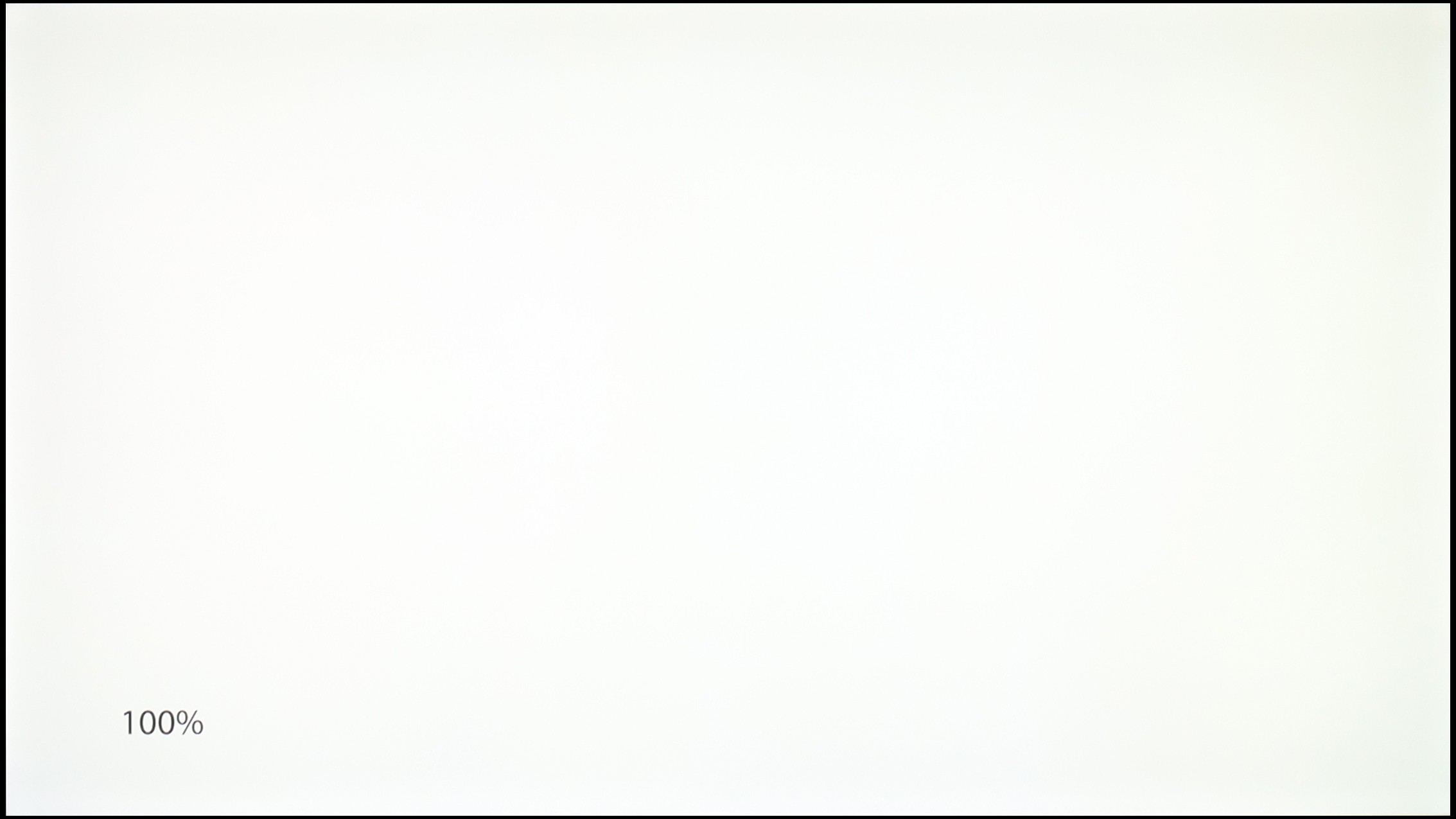
Philips PML9009 / 9019 / 9059
Hisense E8Q
TV features
6/10
8.9/10
- HDMI inputs0 x HDMI 2.0, 4 x HDMI 2.1 48Gbps2 x HDMI 2.0, 2 x HDMI 2.1 48Gbps
- Other inputsRCA (Chinch)
- OutputsToslink (Optical audio), eARC (HDMI), ARC (HDMI), Mini-Jack (Headphones)Toslink (Optical audio), eARC (HDMI), ARC (HDMI), Mini-Jack (Headphones)
- Network InterfacesWi-Fi 2.4GHz, Wi-Fi 5GHz, Ethernet (LAN) 100MbpsWi-Fi 2.4GHz, Wi-Fi 5GHz, Ethernet (LAN) 100Mbps
- TV receptionDVB-T, DVB-T2, DVB-S, DVB-S2, DVB-CDVB-T, DVB-T2, DVB-S, DVB-S2, DVB-C
Classic features:
- Recording to USB (terrestrial TV)
- Recording programming
- Picture in Picture (PiP)
- RF remote control (no need to aim at the screen)
- Backlit remote control
- Teletext
- Audio only mode
- Possibility to connect Bluetooth headphones to the TV
- Possibility to simultaneously use Bluetooth headphones and the TV speaker
Smart features:
- AirPlay
- Screen mirroring (Windows Miracast)
- Wyszukiwanie głosowe
- Voice search in native language
- Ability to connect a keyboard and mouse



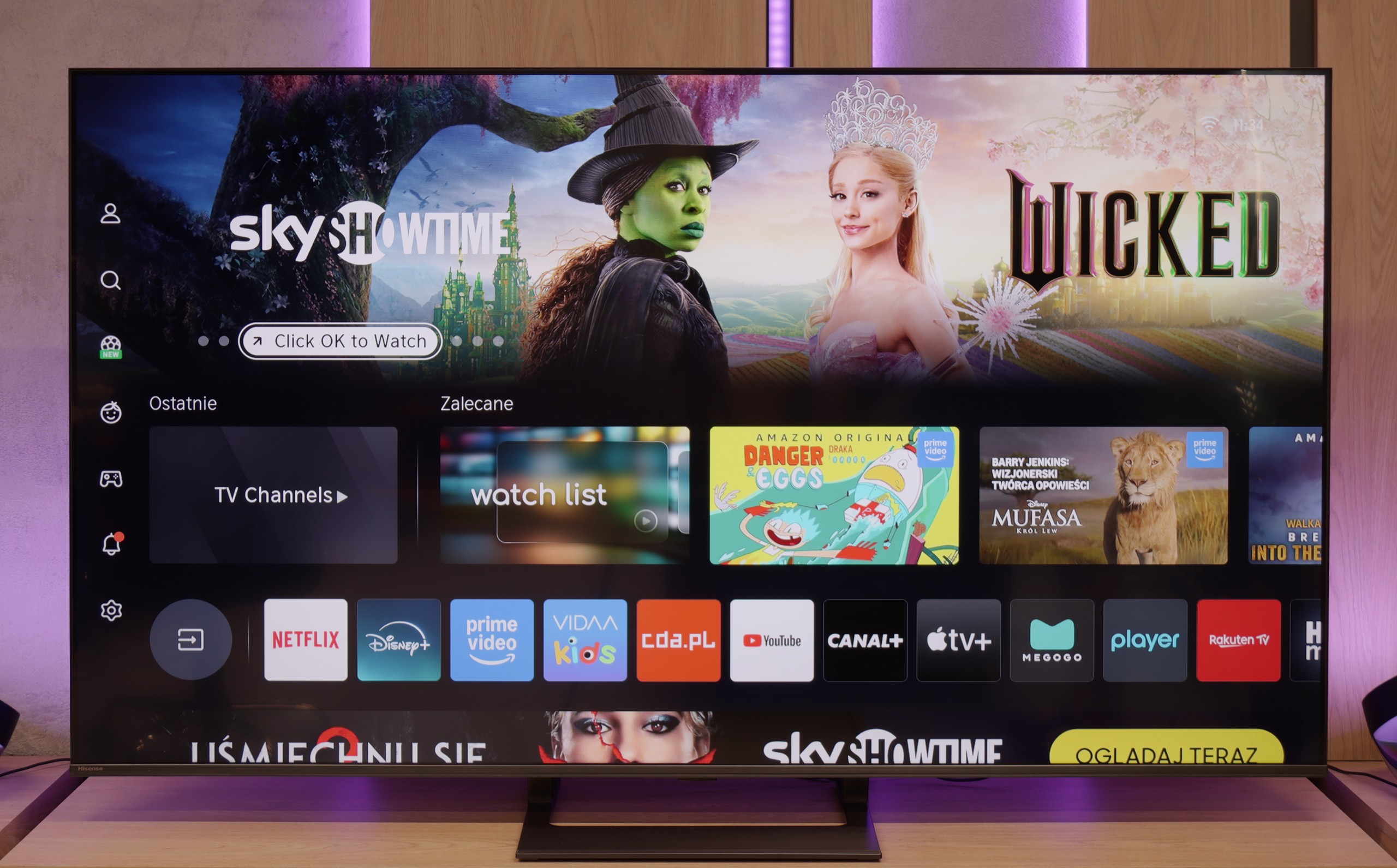
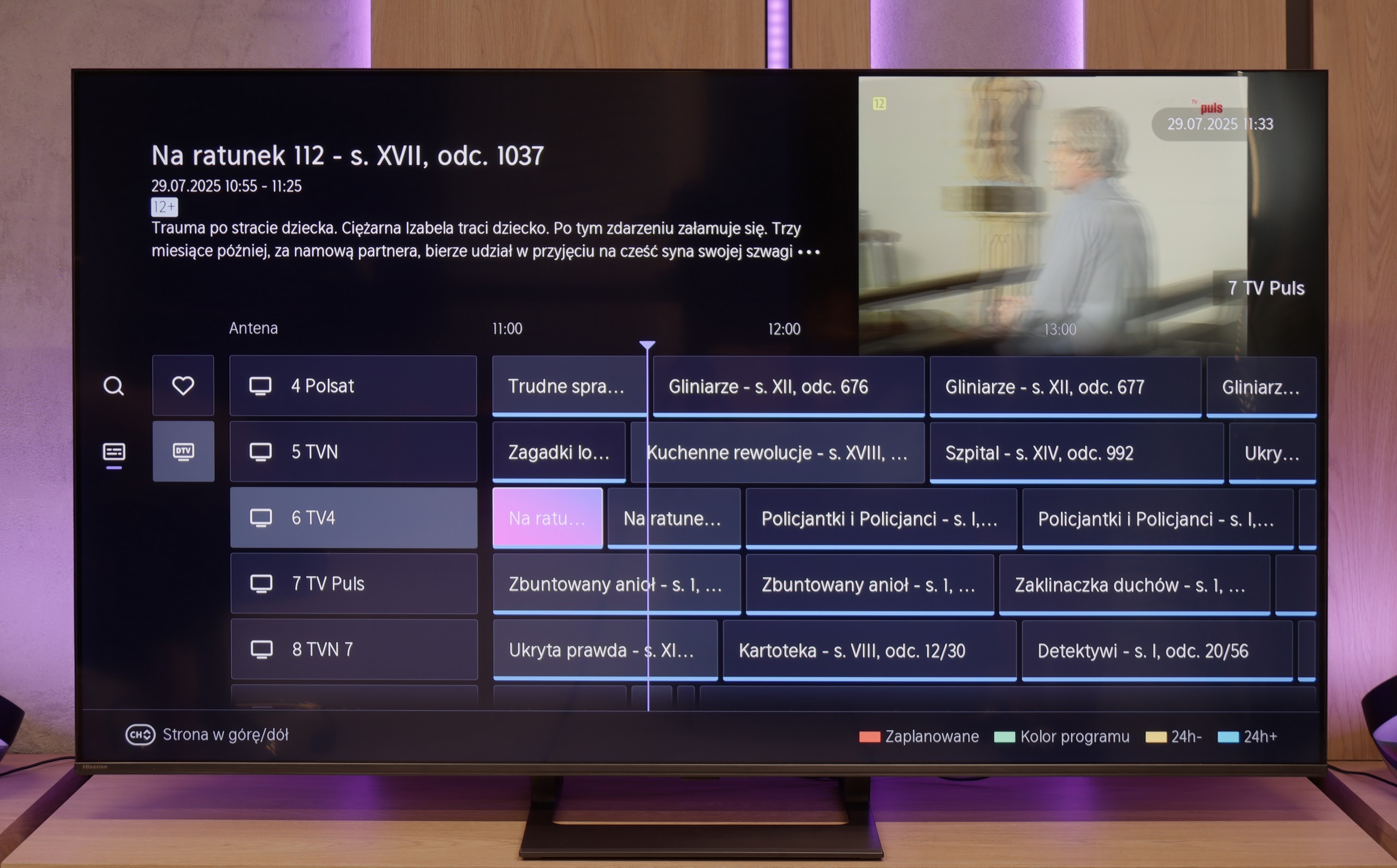


Before we move on to the software that controls the television, it is impossible not to mention the biggest distinguishing feature of the manufacturer's televisions. This is, of course, the multicoloured Ambilight backlighting, which is placed on the back of the device and displays colours tailored to what is happening on the screen, often allowing for an even greater sense of immersion. The operating system responsible for the television's functionality is Philips' proprietary system charmingly named TitanOs. It is definitely more closed and limited in terms of app resources compared to other televisions from the manufacturer that use the GoogleTV system. In addition to a lack of significant applications, its closed nature is also evident in another respect. We will not be able to perform such basic tasks as programming recordings or recording to USB. Those using Apple devices may also feel disappointed by the lack of AirPlay functionality, which allows for easy screen streaming. Fortunately, there is the option to connect a keyboard and mouse for easier navigation through the television menu. It's also worth mentioning that while the remote pairs via BT, it only works for voice selection in English. The rest operates via IR...
In summary: TitanOs has quite a few "buts," especially if we are aware users needing and using many streaming platforms. It is rather an option for those limiting themselves to the so-called holy trinity, which is Netflix, YouTube, and CDA.
Classic Features – E8Q
The Hisense E8Q is not just equipment for gamers or movie enthusiasts – it can also serve as a daily television for the whole family. We can record programmes to USB, connect headphones or speakers via Bluetooth, and the entire interface – including the channel guide – is clear and easy to use. The only thing missing is the PiP function, but apart from that, the set of classic features is really comprehensive.
Smart TV – VIDAA System
The E8Q operates on the VIDAA system, which becomes more refined year after year. Voice search in Polish works flawlessly, and it's easy to stream content from your phone (AirPlay and screen mirroring). The system itself runs smoothly without hiccups, although – as is often the case with closed platforms – there may occasionally be one or two less popular apps missing. Therefore, it's worth checking before purchase whether everything we use on a daily basis is available there.
Playing files from USB
8.2/10
8.2/10
Supported photo formats:
Maximum photo resolution:

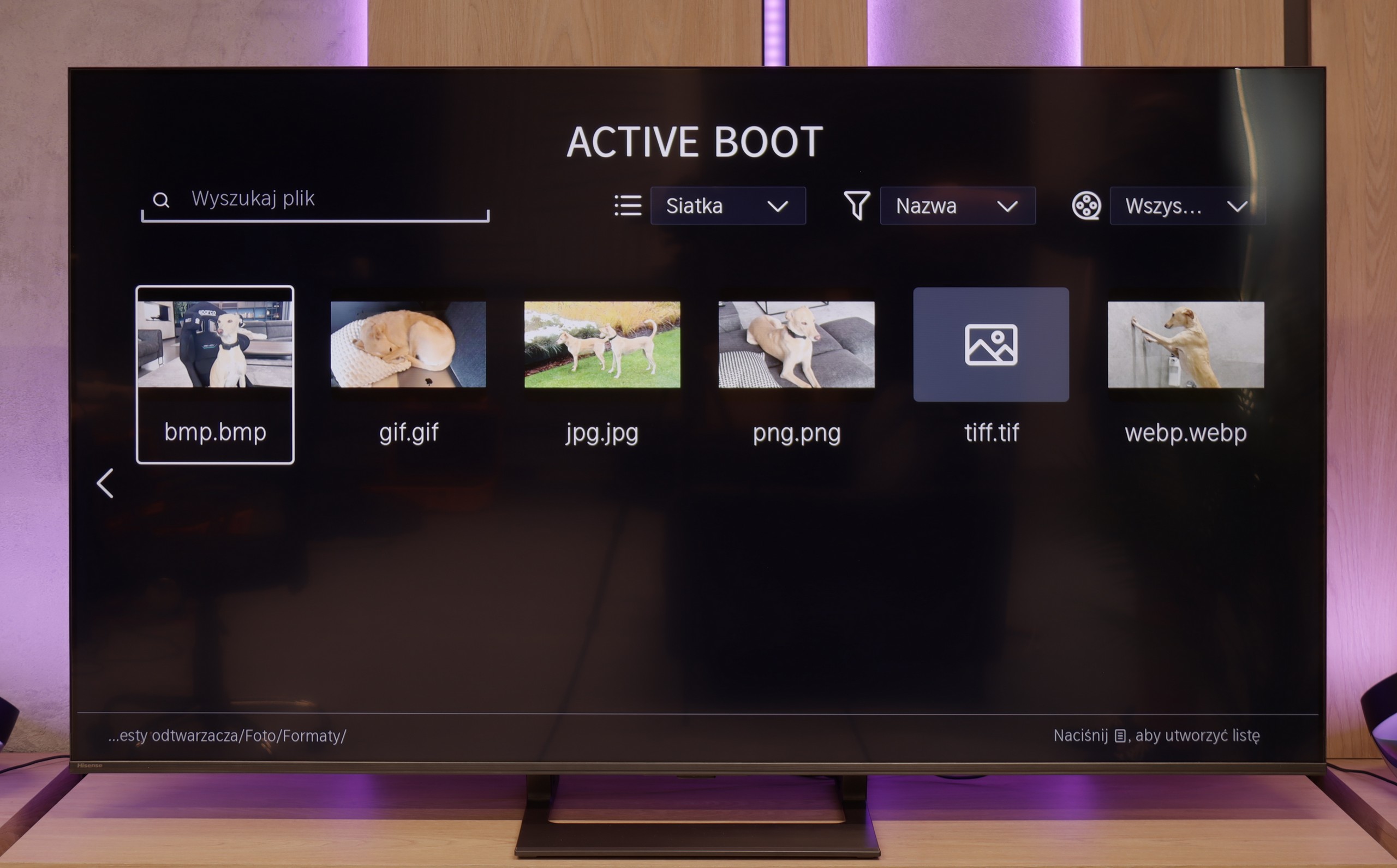
The default media player built into Philips PML9009 offers quite a wide range of capabilities, but it also has its limitations. It plays practically all video formats, except for .asf, which is rather uncommon. However, the issues are the lack of the H.265 HEVC codec at high bitrate and support for .sub files, which are quite popular. When it comes to photos, the player performs adequately, but it lacks support for some common resolutions and formats, such as HEIC, which is used on Apple devices. The player performs best with audio, where it can be faulted in no way. Unfortunately, due to system limitations, there is no possibility to expand its functions, which means we are left with what the manufacturer has prepared.
The built-in media player in the E8Q performs quite well. It supports most popular video and audio formats, and files from USB drives or external disks play without any major issues. Polish characters? They are supported. Subtitles? They work. The only minor drawback is the occasional problem with displaying high-resolution photos – especially those from cameras or smartphones. So, if you plan to show holiday photos on the big screen, it’s worth checking beforehand whether they all load correctly from disk memory or a USB drive.
Apps
6.2/10
7.7/10














































Sound
6.7/10
5.5/10
- Subjective sound quality:6.7/105.5/10
- Dolby Digital Plus 7.1:
- Dolby True HD 7.1:
- Dolby Atmos in Dolby Digital Plus (JOC):
- Dolby Atmos in Dolby True HD:
- DTS:X in DTS-HD MA:
- DTS-HD Master Audio:
To begin with, it is worth noting that sound quality is a subjective matter. The built-in audio system in Philips PML9009 stands out for its clear treble, but the bass is rather flat and significantly worse than in competing models in the same price range.
Unfortunately, the Hisense E8Q did not make the best impression on us. Although on paper it has speakers with a power of 40 W (which is only slightly less than 50 W in the U7Q), in practice the difference is significant – and unfortunately not in favour of the E8Q. During testing, it quickly became apparent that something was amiss. When the volume was turned up above 40–50%, the entire back casing began to resonate, and unpleasant crackling sounds came from the TV. Even during regular viewing, it was hard not to notice this, and certainly – to not hear it. In this form, it is difficult to speak of listening comfort. We do not rule out that this was an issue with a specific test unit, but nonetheless – it is worth keeping this in mind. If you care about good sound, consider connecting a soundbar or… just go for the U7Q, which performs significantly better.


